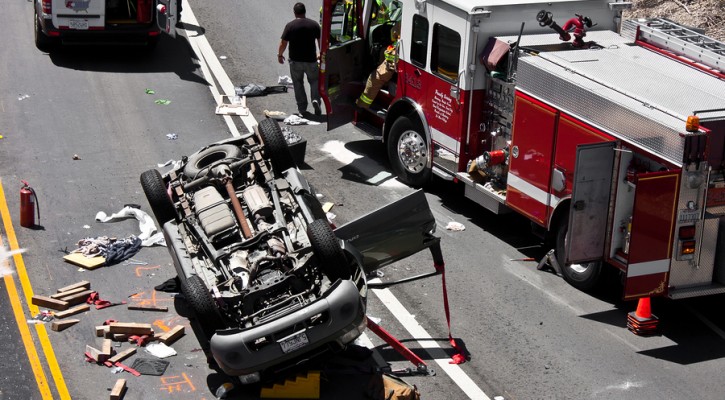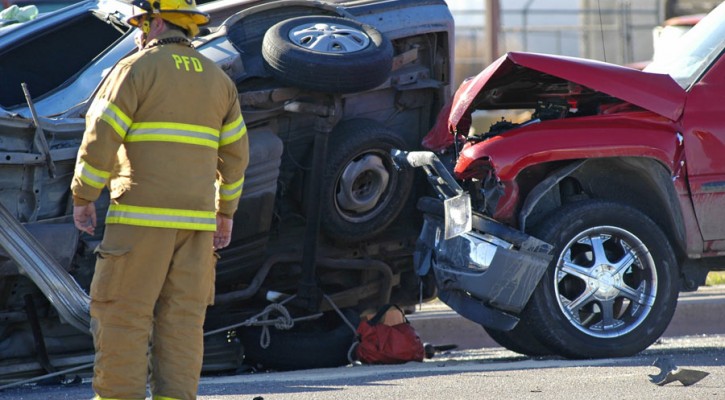
Real Life Hazards Best Driving Experience for Teens
November 26, 2007
Having rain in the forecast is sometimes a good thing when teens are taking a defensive driving course like the one the Mid-Ohio Sports Car Course offers. It just adds one of the elements of driving conditions that teenagers should be prepared for as they learn to drive, especially defensively.
This defensive driving course is for both parents and teens and it can be quite an eye opener, not only for the new teen drivers but for the experienced parent as well. Teen drivers and their parents are put through the paces with such drills as braking when the roads are wet, changing lanes in an emergency and even how to get out of a skid. For the skid drills, there are special cars that are purposely set up to skid so that the teens can learn what it feels like, the panicky feeling they get when it happens and how to push past all that and come out of the skid safely as possible.
When parents don’t have as much time as they should to teach their teens practical on-the-road driving, this defensive driving course can help fill in some blanks. After all, parents are not likely going to allow their teens to skid or drive in the rain in the family car! However, with the course, the instructors want teens to screw up because it will be in a controlled course and they will learn from the mistakes as well as that of others too.
Parents don’t know everything, although they may pretend that they do with their teenagers. So this defensive driving course is a definite eye opener for both parties. Teenagers will have to deal with situations that the parents will never think of, which can be a bit disconcerting for the grown-ups. In a country where as many as 25-30 teens die every day due to vehicle accidents, adding a driving test to your “resume” is a smart move.
While teens crave the independence that the open road will bring, they will not likely think about any potential road hazards they may encounter. They are thinking about switching the CD in the car or finding the windshield wiper switch. The problem is that one small distraction could cause a situation where an accident can occur. With the defensive driving course, hopefully those lessons will kick in instinctively for teens and avert a disaster.
That is the whole purpose for the defensive driving course. It is but another tool of many in the quest to build a safe teenage driving population. The only thing that would be better is making driver’s education a mandatory class once again in school so that each and every teen will have an equal opportunity to learn safe driving habits.

Cool Driving Incentive Makes a Big Teen Impression at a Georgia Fair
October 23, 2007
The Georgia National Fair this year had its requisite rides, games, entertainment and of course, plenty of cotton candy. However, there was an added element that really drew teen crowds – a safe teen driving booth set up in a joint partnership between the Safe America Foundation and the Houston County District Attorney’s Office. Say what? Teens willingly going to an educational booth about safe driving? Well, if the prize was a new car, would you believe it then?
The partnership between the America Foundation and the Houston County District Attorney’s Office was very successful hundreds of teens got the chance to go through a series of simulated driving tests to gauge their driving skills in a variety of situations. In addition, there were some question and answer sessions as well. There was a different round every day with teens progressing through each round until the final test – with a brand new car as the prize. This time a lucky 15 year old won after she successfully proved her safe driving skills and beat out hundreds of other teens.
It is the hope of both parties in this partnership that all of the teens who participated left with a greater sense of accomplishment and confidence in their skills and also walk away with the knowledge of what they need to brush up on in terms of driving skills. Finally, both the Safe America Foundation and the Houston County District Attorney’s Office hope that these teens feel a great sense of responsibility and realize that driving is a privilege that must be earned by good driving behavior.
A few teens who were interviewed after their participation felt that the experience was worth it. Of course, many of them admitted that they would not have stopped by either if it weren’t for the lure of winning a car. This is an understandable position and expected of many teens that live in the moment and don’t really think ahead to the consequences of some of their actions. However, the Safe America Foundation feels that if even just a few teens leave this experience changed, it would have been worth it.
This approach to promoting safe teenage driving is definitely different and applies a different spin to what so many other foundations and entities are trying to do – save our teens from driving accidents and death. Let’s hope that the lessons learned during this 11-day fair actually make a lasting impact with all the teens who participated.
Car Cameras Record Teen Driving Behavior – Yeah or Nay?
October 20, 2007
There are dozens of different statistics about teen driving and they all mesh together with one commonality – traffic crashes are the leading cause of death in teens. Many different entities have created various programs to combat this deadly teenage trend with education programs and reporting systems. However, some insurance companies are taking things a step further – car cameras and GPS equipment to monitor teen driving behavior.
While there has been no official feedback from the teen faction, you can bet there will be some fallout about privacy issues and entitlement. Teens will likely plead to parents that it is not fair and that they have a right to privacy. While the privacy thing is certainly true, what teens should realize is that driving is a privilege and it is every parent’s right to monitor their kids for their own safety if they feel the teens are not ready to handle it on their own.
These cameras will record both video and audio of teen driving habits. Luckily, thus far, the majority of problems have been with inattentiveness rather than aggressive or purposely reckless driving. American Family Insurance is one of the companies that are participating in this program. The footage of the driving behavior is sent to a special media center for analysis where it is evaluated and a “game plan” created to correct the behaviors which is then sent to the parents.
Teens can breathe a sigh of relief that personal conversations and private moments are not relayed to the parents, only information directly related to driving. The camera kicks on via a motion sensor which captures swerving, hard or sudden braking, collision and even hasty acceleration. It is not on the entire time that the teenager is driving.
Another company has introduced the Teensurance program which allows parents to track their teen’s driving behaviors via an onboard GPS system. Parents can set up parameters based on speed, curfew and even distance. In other words, parents are almost behind the scenes remote controllers with their teens at the wheel.
Teenagers are likely not too enthused about this program either as it seems as if their “freedom” is being usurped. So where do we draw the line as parents when it comes to monitoring and protecting our teenage drivers? Do we blindly hand over the keys and cross our fingers? That answer should be a definite no. Instead, these programs like the camera and GPS system are just additional protective tools that are available to the parents for additional peace of mind.
So teens listen up – just go with the flow on these different monitoring devices and learn from them. Within another year or two, those things will be gone and guess what? You will likely not drive any differently because safe driving, thanks to the monitoring, has become an ingrained habit. That is actually a great legacy from your parents but will likely not be appreciated until you mature some more.
The Driver Education Handbook for Parents provides a practical, step-by-step approach to instructing your teen how to become a Safe Driver through behavior, attitude, skills, and experience.

Preventing Teen Vehicular Crashes
October 10, 2007
Geico, the automobile insurance giant, is not just known for their cute gecko or grunting cavemen commercial shtick. They also produce some great informational tools about your insurance and safe driving tips. There is an informational sheet Geico produced about the Top Ten Tips for preventing teenage crashes.
Really, the information is nothing new to anyone but it pays to be repetitive right? Teens probably only really absorb a quarter of what they hear and read when it is not a subject matter they really want to hear about like cleaning their room or *gasp* how to drive responsibly. Perhaps some parents should use the tip handout and tell their teens there will be a pop quiz on it later! Maybe then they will actually read it.
Anyway… there are some tips on there that are not really emphasized on other responsible teen driving diatribes. For instance, one of the tips is keeping it slow and steady and gradually build up to speedier driving venues. What this means is do not start driving lessons with your teen on the major highways that mimic the infamous Autobahn. Instead ease their way into those roads by practicing on driving within small towns or country roads. Practicing those speedy highways during down times is also beneficial. As the teen (and you as the parent) feel more confident about venturing on the highways in the height of craziness, then you can do so.
Another tip that doesn’t get as much play in the teen driving world is training to drive in poor conditions. Many parents are more apt to keep their teens from driving in the rain, snow or other weather conditions. This means, of course, that your teen will have no experience whatsoever in them. The best thing you can do (even though you won’t want to) is to take them out driving, at least in low populated or slow areas, during these conditions. If anything, drive around in the inclement weather in large parking lots, practicing turns and such for the experience. There are less things to hit in an empty parking lot!
Driving a safe vehicle is another safe teen driving tip and one that many people take for granted. Usually, the teen car is either the family car or a hand-me-down. On occasion, a new car or a used model may be purchased. Whatever you choose for your teen to tool around in, you must be sure that it is safe to drive. In this safe teen driving tip, you are the one that holds the ultimate power.

California Jumps on the No Cell Phone for Teen Drivers Bandwagon
September 28, 2007
Governor Arnold Schwarzenegger terminated teen drivers’ rights to talk on the cell phone and drive at the same time through the signing of a bill that will go into effect in July 2008. This bill involves teen drivers under the age of 18 and states that no cell phone use is allowed period while behind the wheel of the car.
There is another bill that is also going into affect at the same time that involves another cell phone and driving situation. In this instance, drivers age 18 and up can use a cell phone but only if it is a hands-free device. No texting and no hand held phones are allowed. The bill restricting the total use of cell phones for teens is in response to collected data that shows inattention of teens are the primary cause of accidents.
While the two bills are nice in theory, there are a few problems with them as well. First of all, how are these going to be enforced effectively? A cop could see a driver going down the road with a cell phone to their ear talking and flash his lights to alert the driver to pull over. Any smart driver would ditch the evidence quickly out of sight to make it a he said/she said scenario. How exactly can the cop prove that the cell phone was in use at the time?
Another thing, the fines for someone getting caught breaking these new upcoming laws are laughable. How exactly are $20 and $50 fines going to be much of an incentive for teens as well as older adults affected? Unless they are habitual offenders and have the worst luck at being caught, these fines are nothing more than a shoulder shrugging, “oh well.”
These laws about cell phone use and driving should be viewed as a first step of many to curb teen accidents and fatalities on the road. While the laws may have trouble being enforced, the essence of them is important. Now the teens know that there are consequences and could have the possibility of having their driving privileges and cell phone taken away from them by the parents. That is what teens are truly afraid of, not being ticketed for it, because some kids have that money as pocket change and can pay the fine without a parent even knowing about it.
The bottom line is that these laws will make the teen pause while driving and decide whether that phone call or text message is truly important. Making teens stopping to think about the consequences of their driving behavior is usually half the battle. The other half is actually the law and parents enforcing the consequences of teen driving behavior.
